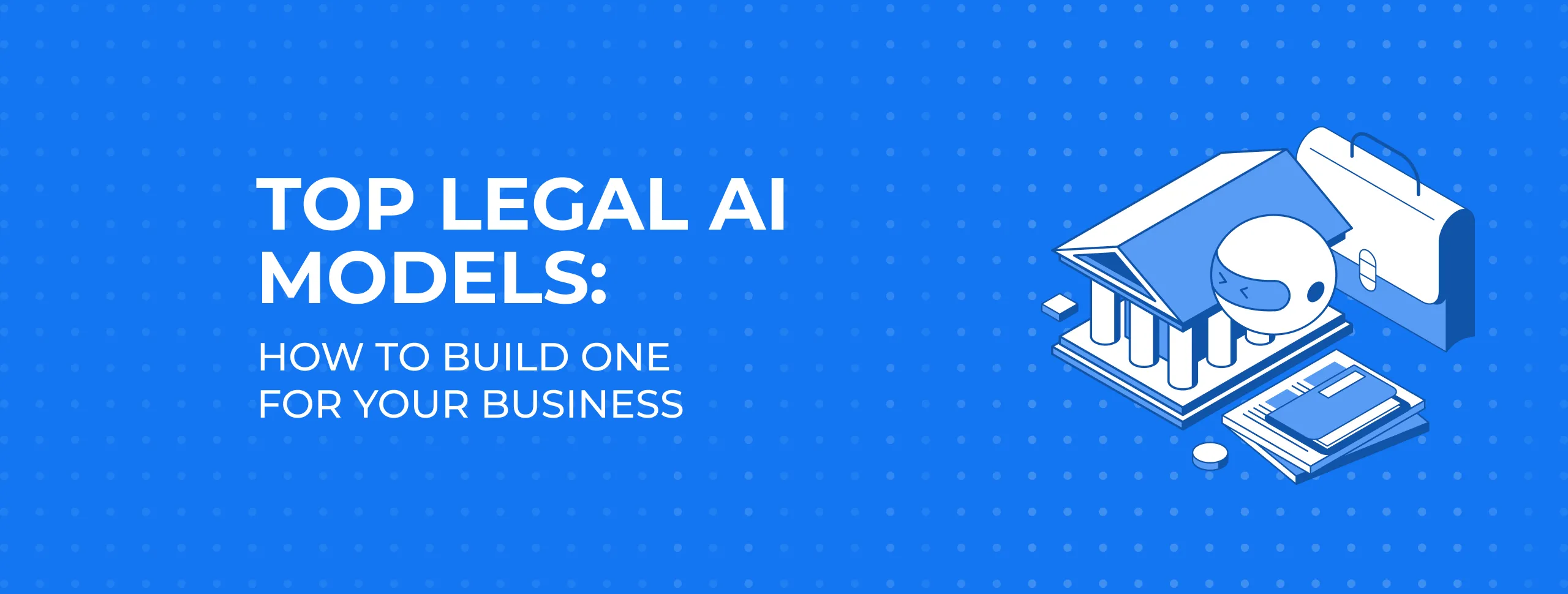
Top Legal AI Models and How to Build One for Your Business

Table of contents
- What are Legal AI Models?
- Top Legal AI Models
- Building Your Own Legal AI Model
- Success Stories
- How Magora Can Help
In a world where lawyers are known for their heavy briefcases and heftier hourly rates, a revolution is quietly underway. The legal landscape is transforming, not in the hands of a fresh wave of litigators, but through the digital brilliance of Artificial Intelligence. The marriage of law and AI is no longer just the stuff of tech startups and Silicon Valley dreams – it's becoming the bedrock of modern legal practices.
But it’s not just the big law firms that are cashing in on this trend. Savvy businesses are now realising they can build their own legal AI models, tailored to their specific needs, without a million-dollar budget.
So, how do you get in on this action? In this article, we give you a step-by-step breakdown of how to build a legal AI model that could change your business forever.

What are Legal AI Models?
Legal AI models are software applications specifically designed to perform complex legal tasks, previously only manageable by seasoned lawyers. At their core, legal AI models use the prowess of natural language processing (NLP), machine learning (ML) , and automation to work through the intricate web of legal language, logic, and procedure.
How They Work
At the core of any legal AI model is Natural Language Processing (NLP), enabling machines to understand, interpret, and respond to human language. NLP acts as the AI's legal dictionary and grammar checker, with superhuman capabilities. It deciphers legalese, identifies key clauses, and extracts key information during document reviews.
ML takes things a step further by enabling the AI to learn from vast datasets of legal texts, cases, and precedents. Over time, the model gets better at spotting patterns, predicting outcomes, and even making decisions based on historical data. It’s like having a lawyer who gets smarter every time they analyse a case.
Finally, there’s automation, which allows these models to execute repetitive and time-consuming tasks without any human intervention. This frees up legal professionals to focus on more strategic work.
Primary Uses of AI in Legal Services
Legal AI models are changing how law firms and businesses handle their day-to-day operations. Here’s where they shine:
-
Document Review: Sifting through mountains of paperwork to find information is a grind. AI models can review documents at breakneck speed. They can highlight important clauses, potential risks, and inconsistencies.
-
Contract Analysis: Contracts are often riddled with complex terms and hidden pitfalls. AI models can dissect contracts. They can flag ambiguous language, missing clauses, and potential legal issues.
-
Legal Research: Researching case law, statutes, and regulations can be tedious. Legal AI models streamline this process by quickly identifying relevant legal precedents and summarising complex legal texts.

Top Legal AI Models
Here are seven of the top AI tools reshaping the legal industry:
IBM Watson Legal
IBM Watson Lega l uses advanced NLP to streamline legal research and contract analysis. It processes vast amounts of data, extracts key information, and offers insights much faster than a human could. Built on the IBM Watson platform, it excels in AI across various domains but doesn't rely on any specific Large Language Model (LLM) like ChatGPT.
ROSS Intelligence
Powered by NLP, ROSS Intelligence was designed to perform legal research by analysing case law and providing answers to legal questions posed by users. Based on IBM's Watson technology, ROSS was widely used until it ceased operations in 2021 due to a legal dispute with Thomson Reuters, which claimed that ROSS had improperly used content from Westlaw's database to train its AI. This case underscores the importance of considering AI ethics and compliance in development, especially for businesses.
Luminance
Luminance uses machine learning to perform document review and contract analysis. It is particularly useful for due diligence processes. The tool can learn from interactions with users, improving its understanding of legal documents over time. It's built on proprietary AI technology and has been praised for its intuitive interface.
Kira Systems
Kira Systems uses ML and AI for law firms and other businesses to extract critical information from contracts. This tool is invaluable for due diligence. It can identify and extract clauses and data points across thousands of documents in a fraction of the time it would take a human. Kira’s AI uses custom machine learning models trained specifically for legal document review.
Ravel Law
This model provides legal research tools with a unique twist – it visualises case law and judicial patterns to offer strategic insights. Built on data analytics and NLP technology, this tool works as an AI lawyer to help users understand how cases are cited and how judges tend to rule. This makes it a powerful option for businesses seeking strategic legal insights.
Casetext
Casetext is an AI-powered legal research platform that also assists with document drafting. It uses the "Parallel Search" feature, which allows users to search for legal concepts rather than just keywords. Casetext’s AI, known as CARA A.I., is built on NLP technologies and has been integrated with models such as OpenAI's GPT-3 and GPT-4 for some of its functionalities.
Legal Robot
Legal Robot uses deep learning, such as BERT (Bidirectional Encoder Representations from Transformers) and RoBERTa (A Robustly Optimised BERT Pretraining Approach), and NLP to analyse and evaluate legal documents for compliance. It is particularly useful for understanding the readability and enforceability of contracts. Legal Robot’s AI uses a variety of machine learning techniques and models to understand legal language and suggest improvements.
Harvey
Harvey is a generative AI tool designed to assist with various legal tasks, including drafting and legal research. It leverages advanced large learning models such as OpenAI's GPT-4 and similar transformer-based architectures to generate legal documents, automate repetitive tasks, and provide insights based on complex legal data.
Building Your Own Legal AI Model
Creating a legal AI model is like assembling a legal powerhouse from scratch – one that can rapidly analyse complex documents, offer insights, and streamline legal processes. Here's how you can build your own legal AI model:
.webp)
1. Data Collection
The foundation of any AI model is high-quality data. For a legal AI model, you'll need to gather an extensive dataset that includes:
-
Rulings and Case Law: Key judicial decisions, especially from higher courts, vital for understanding precedents.
-
Contracts and Legal Agreements: Examples of legal language and structure, crucial for contract analysis.
-
Statutes and Regulations: Laws and regulations forming the core of legal compliance.
-
Legal Textbooks and Journals: Scholarly articles offering in-depth legal analysis and interpretation.
-
Public Legal Databases: Resources like Westlaw, LexisNexis, and PACER provide comprehensive access to legal documents.
-
Government Publications: Reports and guidelines from government agencies essential for regulatory compliance.
2. Labelling or Annotating Legal Text
Once you have your dataset, the next step is labelling the data. This involves:
-
Task-Specific Labelling: Annotating legal texts for specific tasks, such as tagging certain clauses in contracts (e.g., indemnity, confidentiality) or marking relevant case law for a particular legal issue.
-
Training Data Preparation: These labels help the AI model learn what to look for and how to interpret different legal contexts.
3. Preprocessing the Data
Before feeding data into your AI model, it must be preprocessed to ensure it's in a format the model can work with. Key preprocessing steps include:
-
Tokenization: Breaking down text into individual words or phrases (tokens) to simplify analysis.
-
Removing Stopwords: Eliminating common words (like "and," "the," etc.) that don’t contribute much meaning in legal analysis.
-
Punctuation Handling: Deciding how to treat punctuation, which can be crucial in legal texts where punctuation can change meanings.
-
Normalising Text: Converting text to a standard format, such as lowercasing, to ensure consistency across the dataset.
4. Model Selection and Fine-Tuning
Now comes the heart of the process; choosing and training your AI model:
-
Choosing a Base Model: Start with a pretrained model like GPT-3 or LegalBERT, known for understanding and generating human language.
-
Fine-Tuning: Adjust the model using your specific legal data to ensure it comprehends legal jargon and context.
-
Domain-Specific Training: Models like LegalBERT, specifically trained on legal texts, may outperform general models like GPT in legal tasks.
5. Compliance and Ethical Considerations
Legal AI must adhere to both legal standards and ethical guidelines:
-
Legal Standards: Ensure your AI complies with regulations like the GDPR (for data privacy) or specific industry regulations (e.g., HIPAA for health law).
-
Ethical Guidelines: Consider fairness, transparency, and accountability. For example, ensure your AI does not perpetuate biases present in legal data.
-
Bias Mitigation: Actively work to reduce any biases in your model, particularly those that could affect outcomes.
6. Continuous Learning and Updating
The legal landscape is ever-changing, so your AI model must adapt:
-
Feedback Loop: Establish a continuous learning mechanism where the AI model is regularly updated based on new data and user feedback.
-
Ongoing Training: Periodically retrain your model with the latest legal data to ensure it remains relevant.
-
Performance Monitoring: Regularly evaluate the model’s performance and make adjustments as needed to improve accuracy.
hbspt.forms.create({ region: "eu1", portalId: "26569210", formId: "567a6530-7da7-442a-894c-1622147ffc93" });
Success Stories
Reed Smith LLP
Reed Smith LLP, a global law firm, implemented Luminance, an AI-powered document review tool, for due diligence and contract analysis. This integration reduced document review time from weeks to days, saving time and costs. Clients enjoyed faster service and improved accuracy, enhancing overall satisfaction.
Baker McKenzie
Baker McKenzie, one of the world's largest law firms, adopted ROSS Intelligence AI for legal research. The AI's NLP capabilities enabled rapid review of case law and precedents, cutting research time significantly. This led to improved productivity, reduced costs, and allowed lawyers to focus on strategic advice. The firm also saw higher client satisfaction from faster turnaround times and more thorough legal insights.
Allen & Overy
Allen & Overy has adopted Harvey, an AI platform powered by OpenAI's ChatGPT, to enhance client services. Designed specifically for legal applications, Harvey aids in research and contract analysis. Since its trial began in November, the firm has used Harvey for about 40,000 queries. The platform supports multiple languages and diverse practice areas, significantly boosting efficiency and offering innovative solutions.

How Magora Can Help
Magora can assist your business to build an AI model for legal purposes through a structured process:
-
Discovery Phase: We start by understanding your specific needs. We gather requirements, and analyse the legal tasks you want to automate. This phase involves in-depth discussions and research to ensure that the AI solution aligns with your business goals.
-
Development: Once requirements are clear, our experts build your legal AI model by selecting tools, collecting and labelling data, preprocessing, and training the model. We customise it to meet your specific legal needs, ensuring effectiveness and efficiency. Throughout development, our product owners guide the project, translating your vision into actionable tasks and ensuring the effective creation of the model from scratch.
-
Training: After the model is built, we train your team to use the AI effectively. We provide hands-on training sessions and documentation to ensure that your staff can fully leverage the AI model’s capabilities.
-
Testing: Before going live, we rigorously test the AI model to ensure accuracy, reliability, and compliance with legal standards. This testing phase involves real-world scenarios to identify and fix any potential issues.
-
Maintenance: Post-deployment, Magora provides ongoing maintenance and support. This includes performance monitoring, updates with new legal data, and necessary upgrades to align the AI with evolving legal standards.
By partnering with Magora, your business can confidently implement a cutting-edge legal AI model that boosts efficiency and enhances client satisfaction. Contact us today to discuss your needs.





